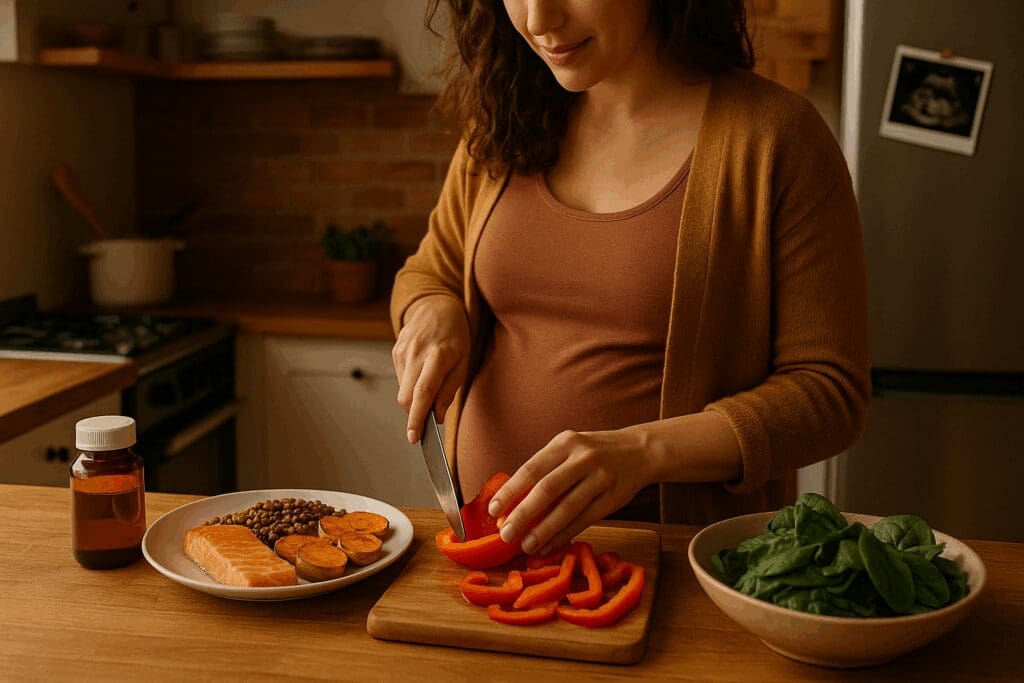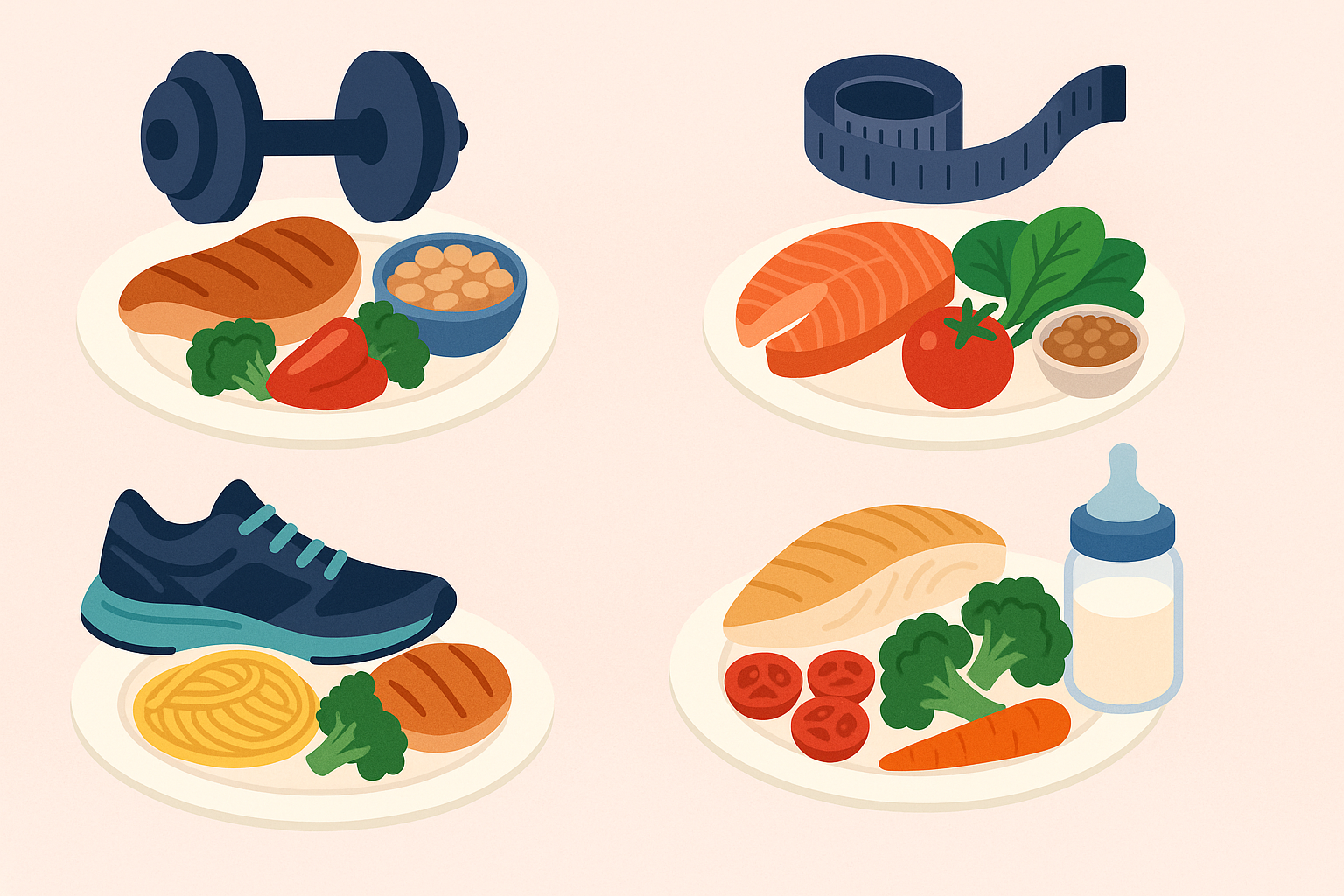Women’s nutritional needs are dynamic and evolve significantly across different phases of life, from adolescence to postmenopause. Each stage brings distinct physiological changes—such as menstruation, pregnancy, lactation, and menopause—that influence metabolic rate, nutrient absorption, and energy requirements. A healthy balanced diet for women is not a one-size-fits-all prescription but a flexible, personalized strategy that prioritizes nutrient-dense foods to optimize physical health, hormonal balance, and emotional well-being. Proper nourishment becomes the cornerstone of vitality, resilience, and disease prevention, particularly as women navigate complex demands on their time, energy, and biological systems. A comprehensive understanding of these dietary needs allows women to make informed decisions, empowering them to thrive at every age with strength and confidence.
You may also like: 10 Essential Tips on Choosing Healthy Food for Ladies to Boost Energy and Wellness

Nutrition in Adolescence: Building Foundations for Lifelong Health
Adolescence marks a critical window for growth and development, during which the body undergoes rapid hormonal and structural changes. For young women, this period is especially significant due to the onset of menstruation and the concurrent demand for increased iron, calcium, and folate. An iron-rich diet, featuring lean meats, beans, spinach, and fortified cereals, is essential to counteract menstrual blood loss and support energy metabolism. Calcium and vitamin D are vital for developing peak bone mass, which can help reduce the risk of osteoporosis later in life. Dairy products, fortified plant milks, leafy greens, and sunlight exposure should be prioritized to meet these needs.
Moreover, adolescence is often when lifelong dietary patterns and attitudes toward food are formed. A healthy balanced diet for women during these years should also consider mental health, body image, and the potential risk of disordered eating behaviors. Encouraging variety, moderation, and intuitive eating practices helps establish a positive relationship with food. Meals rich in whole grains, fresh fruits, vegetables, and sources of healthy fats not only provide essential nutrients but also teach young women how to fuel their bodies for learning, physical activity, and emotional regulation.
Importantly, this is also the time when habits around processed food, sugar consumption, and snacking can either support or undermine long-term wellness. Reducing sugary beverages and encouraging hydration with water or herbal teas helps avoid insulin spikes and supports cognitive clarity. By establishing these foundational dietary habits early, young women are better positioned to carry their nutritional awareness into adulthood with confidence and competence.

Fertility, Conception, and Preconception Wellness
As women enter their twenties and thirties, many begin to consider fertility, whether for immediate conception or future planning. Nutritional choices during this stage are pivotal for reproductive health, hormonal balance, and egg quality. A healthy balanced diet for women seeking to optimize fertility should emphasize antioxidants, omega-3 fatty acids, and micronutrients like zinc, selenium, choline, and folate. These compounds support ovulation, reduce oxidative damage to reproductive tissues, and enhance hormonal regulation.
Leafy greens, citrus fruits, lentils, and avocado are excellent sources of folate, which is especially important before and during early pregnancy to prevent neural tube defects. Choline, often under-consumed, is vital for fetal brain development and can be obtained from eggs, soybeans, and lean meats. Omega-3s, found in fatty fish such as salmon and sardines, play a key role in reducing inflammation and supporting healthy cervical fluid production.
Balancing blood sugar levels is also critical during this life stage, particularly for women with polycystic ovary syndrome (PCOS), a common condition affecting fertility. Emphasizing low-glycemic carbohydrates, such as quinoa, legumes, and whole oats, alongside regular meals that include protein and healthy fats, helps regulate insulin and support ovulatory function. Additionally, avoiding excessive caffeine and alcohol while increasing intake of hydration-rich foods can support endocrine function and create an optimal environment for conception.

Eating for Pregnancy: Nourishment for Two
During pregnancy, a woman’s nutritional needs increase substantially to support the growth and development of the fetus, as well as the health of the mother. This period demands strategic nutrient intake, not excessive caloric consumption. A healthy balanced diet for women during pregnancy emphasizes whole, unprocessed foods that supply a robust spectrum of vitamins, minerals, fiber, and macronutrients. While calorie requirements do rise—particularly in the second and third trimesters—the focus should remain on nutrient density rather than quantity.
Iron becomes even more critical during this time, as maternal blood volume increases by nearly 50%, requiring increased hemoglobin production. Iron-rich foods such as grass-fed red meat, lentils, pumpkin seeds, and fortified cereals should be included daily, ideally paired with vitamin C-rich produce like bell peppers or oranges to enhance absorption. Folate continues to be essential, not only in early pregnancy but throughout gestation, due to its role in cellular division and DNA synthesis.
Protein needs also increase, supporting the development of fetal tissues and the expansion of maternal blood supply. High-quality sources like lean meats, fish, eggs, legumes, and tofu should be consumed regularly. Additionally, omega-3 fatty acids are vital for fetal brain and eye development, and should be sourced from low-mercury fish or algae-based supplements when necessary. Maintaining consistent intake of calcium and magnesium supports skeletal development and may also reduce the risk of preeclampsia.
To manage common pregnancy symptoms such as nausea, constipation, and acid reflux, women can adopt smaller, more frequent meals rich in fiber and hydration. Including ginger, peppermint tea, and probiotic foods like yogurt and kefir may provide relief. Careful attention to diet during pregnancy establishes not only immediate maternal-fetal health but sets the foundation for infant health and maternal recovery.

Postpartum Nutrition and the Demands of Breastfeeding
The postpartum period is one of profound physiological transition. After childbirth, women require a nutrient-dense diet to recover from delivery, manage hormonal shifts, and, if breastfeeding, produce quality milk. A healthy balanced diet for women in this stage focuses on replenishing iron stores lost during childbirth, healing tissues, and supporting energy levels. Fatigue is common, and nutrient gaps can compound emotional challenges like postpartum depression or anxiety.
Breastfeeding mothers have increased needs for calories, fluids, and several nutrients, including vitamin A, iodine, and omega-3 fatty acids. These should be met through an intentional diet that includes leafy greens, sweet potatoes, fatty fish, eggs, nuts, and seaweed. Bone broth and slow-cooked stews offer collagen, gelatin, and amino acids that support tissue repair and joint recovery. Hydration is essential; lactating women should drink water consistently throughout the day, as breast milk is approximately 90% water.
Women should also be mindful of their mental health during this time. Nutrients like vitamin D, B12, zinc, and magnesium play roles in mood regulation, sleep quality, and stress response. Reintroducing regular meals, supported by family or community structures, can help prevent erratic eating patterns that affect blood sugar and energy. While weight loss may be a goal for some women postpartum, it should never come at the expense of nourishment, particularly when breastfeeding. Gentle physical activity combined with a balanced dietary approach ensures sustainable recovery and long-term wellness.

Navigating Nutritional Needs Through Perimenopause
Perimenopause typically begins in a woman’s forties and is characterized by fluctuating estrogen and progesterone levels that can affect mood, metabolism, sleep, and bone health. A healthy balanced diet for women at this transitional stage must adjust to changing energy requirements while prioritizing hormonal and cardiovascular support. As metabolism slows and lean muscle mass begins to decline, nutrient-dense foods become increasingly important to meet needs without excess caloric intake.
Phytoestrogens—plant compounds that mimic the action of estrogen—may provide symptom relief for hot flashes and hormonal instability. Sources like soy, flaxseed, and sesame seeds can be incorporated into meals for their gentle balancing effects. Calcium and vitamin D continue to be critical for preserving bone density, particularly as estrogen, which has a protective effect on bones, begins to wane. Fatty fish, leafy greens, fortified plant milks, and occasional sunlight exposure are essential dietary elements.
Perimenopausal women also benefit from increased intake of magnesium, found in legumes, seeds, dark chocolate, and whole grains, which supports sleep quality and stress reduction. To combat bloating and digestive changes, fiber remains a priority, sourced from vegetables, fruits, and ancient grains. Avoiding highly processed foods, excessive alcohol, and added sugars helps stabilize mood swings and reduces the risk of insulin resistance and cardiovascular disease. This life stage calls for a mindful recalibration of the diet and lifestyle to maintain vitality and mitigate common symptoms of transition.

Menopause and Beyond: Maintaining Strength, Clarity, and Longevity
After menopause, nutritional strategies shift again to accommodate a post-reproductive hormonal profile. A healthy balanced diet for women in their fifties and beyond is rooted in maintaining bone density, preserving muscle mass, and reducing chronic disease risk. Estrogen levels drop sharply during menopause, increasing vulnerability to osteoporosis, heart disease, and weight gain, particularly around the abdomen. Therefore, dietary choices must emphasize foods that counteract these risks.
Protein becomes especially important to prevent sarcopenia, the age-related loss of muscle. Including 20–30 grams of high-quality protein at each meal—from sources such as eggs, fish, legumes, tofu, and lean meats—can preserve lean body mass and metabolic efficiency. Calcium and vitamin D remain essential, and supplements may be necessary if food alone is insufficient. Additionally, omega-3 fatty acids continue to play a role in protecting against inflammation and cognitive decline.
Cognitive support is another critical focus in later life. B vitamins, particularly B6, B12, and folate, contribute to neurological function and should be emphasized through foods like leafy greens, beans, eggs, and whole grains. Hydration, often overlooked, becomes crucial for maintaining energy and preventing urinary tract infections and constipation. Small, frequent meals rich in fiber, protein, and healthy fats help stabilize blood sugar and energy levels throughout the day.
Maintaining a colorful, varied plate ensures a wide range of phytonutrients, antioxidants, and anti-inflammatory compounds that promote longevity and vitality. With thoughtful adjustments and continued movement, women in this life stage can enjoy a vibrant, active lifestyle well into their senior years.
Structuring a Healthy Meal Routine That Supports All Life Stages
Regardless of age or life phase, the structure of meals plays a key role in sustaining energy, mood, and metabolic health. A healthy meal routine that includes three balanced meals and one or two optional snacks provides steady glucose supply to the brain and muscles, supports hormonal regulation, and prevents overeating or emotional eating patterns. A well-structured diet also aligns with circadian rhythms, promoting better sleep and digestion.
Each meal should contain a mix of complex carbohydrates, lean protein, and healthy fats, ideally complemented by fiber-rich vegetables. For example, breakfast might consist of steel-cut oats topped with chia seeds, berries, and almond butter; lunch could feature grilled salmon over quinoa with steamed broccoli and tahini dressing; while dinner might be a lentil and vegetable stew with a side of leafy greens. Snacks like hummus with carrot sticks or a boiled egg with avocado toast can bridge energy gaps and improve nutrient intake.
Meal planning plays a significant role in the long-term success of any nutrition approach. A consistent diet nutrition plan reduces decision fatigue, prevents last-minute poor food choices, and allows for strategic nutrient coverage. Cooking at home more frequently, organizing shopping lists around whole-food staples, and preparing meals in batches all enhance dietary adherence and satisfaction.

Specialized Nutrition Plans Tailored to Women’s Fitness and Weight Goals
Women’s dietary goals often include optimizing physical performance, building strength, or achieving healthy weight loss. To address these objectives, specialized nutrition plans must account for unique physiological differences such as hormonal fluctuations, fat distribution patterns, and muscle composition. The best fitness diet plan for women will always be one that provides adequate fuel for movement while supporting recovery and body composition goals.
For weight loss, a fat loss diet plan for male individuals may not align with the hormonal needs of women. Female hormones, particularly estrogen and progesterone, require a delicate balance of macronutrients to avoid energy crashes, mood swings, or menstrual irregularities. Diets that work for women typically prioritize sustainable habits over aggressive calorie restriction, emphasizing nutrient timing, quality carbohydrates, and high-fiber, plant-rich foods.
The best workout diet for weight loss supports lean muscle retention through ample protein and provides complex carbohydrates to power workouts. Examples include smoothies made with plant protein, berries, spinach, and oats, or post-workout meals like sweet potatoes with turkey and sautéed kale. Women engaged in resistance training or high-intensity workouts may also benefit from branched-chain amino acids (BCAAs) and magnesium to support muscle repair and reduce soreness.
Diet programs should be customized to lifestyle and activity level, whether the goal is endurance, strength, flexibility, or general wellness. Fitness food plans that rotate seasonal produce, lean proteins, and whole grains prevent boredom and micronutrient gaps. Avoiding restrictive or fad-based approaches is key, and free weight loss programs that include coaching, community, and education can offer accountability without the pitfalls of extreme dieting.
Understanding Popular Weight Loss Programs and Their Limitations
The marketplace is flooded with top rated weight loss programs, many of which make sweeping promises that often fail to deliver long-term results. While some structured plans offer useful tools, others can be overly rigid, nutritionally inadequate, or psychologically damaging. A healthy balanced diet for women should steer clear of plans that eliminate entire food groups, promote rapid weight loss, or neglect the importance of food enjoyment and sustainability.
Some of the most effective and easy weight loss diets to follow are those that emphasize mindful eating, realistic calorie targets, and education around portion sizes. Weight loss websites and apps can be useful when they encourage self-monitoring, meal tracking, and gradual habit change. However, dependency on external tracking without internal awareness can backfire, leading to obsessive behaviors or guilt.
The best diet for women is one that fosters autonomy and resilience. It should address emotional eating, stress management, sleep hygiene, and body image, which all influence weight regulation. For some, joining dietary programs with group support and professional coaching can be empowering, but only if the environment prioritizes health over appearance and offers strategies for long-term maintenance.
Ultimately, what diet is best for me is a question that every woman should ask herself in the context of her goals, lifestyle, preferences, and health status. Personalized dietary plans that evolve over time will always outperform rigid templates that ignore individuality.
Frequently Asked Questions About Building a Healthy Balanced Diet for Women
1. What are the long-term benefits of following a healthy balanced diet for women?
A healthy balanced diet for women supports more than just weight management—it plays a critical role in hormonal regulation, immune strength, and mental well-being. Nutrients like omega-3 fatty acids, iron, calcium, and folate help prevent age-related diseases such as osteoporosis, anemia, and cardiovascular disorders. By maintaining blood sugar stability through a consistent nutrition meal plan, women can reduce the risk of insulin resistance and polycystic ovary syndrome. Over the years, adherence to a proper diet for women can also delay cognitive decline and promote skin health. These long-term outcomes make dietary commitment more than just a short-term lifestyle choice—it becomes an investment in future vitality.
2. How can women tailor the best fitness diet plan to align with hormonal fluctuations?
The best fitness diet plan for women must adapt to hormonal shifts throughout the menstrual cycle, pregnancy, and menopause. For instance, during the luteal phase, increased cravings may require complex carbs and magnesium-rich foods to balance mood and prevent binge eating. In perimenopause and menopause, incorporating a specialized nutrition plan high in phytoestrogens—like flaxseeds and soy—can help ease symptoms like hot flashes and fatigue. Exercise recovery also changes with hormone levels, so adjusting protein intake accordingly within a fitness food plan is essential. Rather than a static dietary approach, a dynamic diet and exercise plan that evolves with biological changes offers sustained success.
3. What role does emotional well-being play in choosing the best diet for women?
Emotional alignment with a dietary plan is often a forgotten piece of the puzzle when seeking diets that work for women. If a dietary plan is too rigid, it may provoke guilt, restriction, and disordered eating patterns. The best diet for women fosters self-respect and body awareness, allowing flexibility and enjoyment while maintaining health. Practices like mindful eating, journaling, or participating in free weight loss programs with built-in mental wellness support can improve adherence. A psychologically nourishing diet health program should enhance, not hinder, emotional resilience.
4. How can a healthy diet meal plan support both muscle development and fat loss?
A healthy diet meal plan can simultaneously support lean muscle gain and fat reduction when macronutrients are strategically balanced. For women focused on strength, a fitness fat loss diet that includes lean protein, moderate carbs, and essential fats allows for muscular repair without bloating or fatigue. Nutrient timing—such as consuming carbs post-workout and protein before bed—can boost metabolism and recovery. Integrating the best workout diet for weight loss with strength training ensures optimal composition change rather than just scale reduction. This synergy between diet and exercise yields sustainable outcomes beyond aesthetic results.
5. How does a healthy balanced diet for women differ from dietary plans tailored for men?
Although there are shared principles across both sexes, a healthy balanced diet for women often emphasizes different micronutrient profiles than a fat loss diet plan for male individuals. Women, for example, typically need more iron due to menstruation and may require higher calcium and vitamin D as they age. Meanwhile, a diet plan for weight loss for male individuals may focus more heavily on muscle-building macros and caloric surplus periods. Tailored approaches that factor in hormonal cycles, metabolism, and nutrient absorption differences provide more precise results than generalized diet programs. Understanding gender-specific needs leads to better outcomes in both health and performance.
6. What should women look for when comparing top rated weight loss programs?
When evaluating top rated weight loss programs, women should consider sustainability, personalization, and evidence-based structure. Programs that promote easy weight loss diets to follow often lack nutritional integrity or long-term viability. Instead, effective dietary programs include accountability features, healthy meal routines, and adaptable diet nutrition plans. Women should prioritize platforms that offer food tracking, emotional support, and realistic timelines for transformation. Reviewing success rates and user testimonials—particularly on weight loss websites—can also help determine which diet programs are actually aligned with women’s diverse health goals.
7. How can busy women simplify adherence to a healthy balanced diet for women?
A hectic lifestyle shouldn’t be a barrier to following a healthy balanced diet for women. Prepping meals in batches based on a weekly dietary plan saves time and reduces reliance on ultra-processed food. Using tools like a healthy diet table or digital planners can streamline shopping lists and macro tracking. Subscribing to curated fitness food plans or leveraging free weight loss programs with recipe libraries can also provide structure. Most importantly, focusing on consistency—not perfection—ensures the dietary pattern becomes a natural part of the daily routine.
8. Can popular weight loss programs really offer long-term solutions for women?
Popular weight loss programs can offer a valuable starting point, but their effectiveness depends on individualization and support beyond calorie counting. Many women benefit from transitioning from these initial programs to more nuanced diet health programs that evolve with their changing needs. Sustainable progress typically stems from combining elements of structured programs with a healthy meal routine and ongoing lifestyle coaching. To transform a temporary solution into a permanent lifestyle, women must integrate nutrition education and behavior change. That’s why the best weight loss system isn’t the trendiest—it’s the one that grows with you.
9. What is the importance of a correct diet plan during different stages of womanhood?
From adolescence to postmenopause, a woman’s body undergoes multiple changes that call for a correct diet plan at each stage. Teenage girls benefit from nutrient-dense foods that support bone growth, while women in childbearing years need folate, iron, and B12 for reproductive health. During menopause, estrogen reduction can increase the risk of metabolic syndrome, making a tailored diet nutrition plan vital for cardiovascular protection. With age, digestive efficiency may decline, requiring easier-to-digest foods within a proper diet for women. Each life phase demands specialized nutrition plans to meet shifting physiological demands.
10. How can women find out what diet is best for me without falling into the trap of trends?
Determining “what diet is best for me” starts with self-awareness, medical guidance, and lifestyle alignment rather than chasing trends. A professional nutritionist can help interpret lab markers and create a customized nutrition meal plan based on personal goals, allergies, and fitness levels. Digital tools like metabolic tests, wearable fitness trackers, and diet analysis apps offer deeper insight into what’s truly working. Women should also ask whether a diet is compatible with their cultural preferences, social habits, and long-term emotional health. The best diet for women is one that evolves with them—and not one that forces them to change who they are.
Conclusion: Embracing a Healthy Balanced Diet for Women as a Lifelong Journey
Women’s health is deeply intertwined with the quality, rhythm, and intentionality of their nutrition. Embracing a healthy balanced diet for women means more than meeting calorie needs or following the latest diet trend—it’s about nurturing the body in a way that respects its natural rhythms and evolving requirements across every life stage. From adolescence through pregnancy, perimenopause, and beyond, women encounter distinct physiological transitions that require adaptive, supportive nourishment.
When dietary choices are aligned with each stage of life, they can protect against chronic disease, enhance mood and energy, and support reproductive and cognitive health. Whether through a structured diet plan for weight loss for male or female individuals, a free weight loss program, or a personalized diet health program guided by a clinician, what matters most is sustainability, nutrient quality, and body awareness.
A proper diet for women must always consider more than the scale. It must empower strength, fertility, grace in aging, and mental clarity. With the right diet nutrition plan, each woman can cultivate a resilient foundation that sustains her through the complexities of modern life.
By tuning into personal needs, experimenting with specialized nutrition plans, and avoiding the pitfalls of extreme popular weight loss programs, women can reclaim their health, energy, and confidence. In the end, a truly healthy diet meal plan doesn’t just nourish—it liberates. It equips women to live fully, love their bodies, and thrive at every step of the journey.
Further Reading:
Clean-Eating Meal Plan for Beginners, Created by a Dietitian



